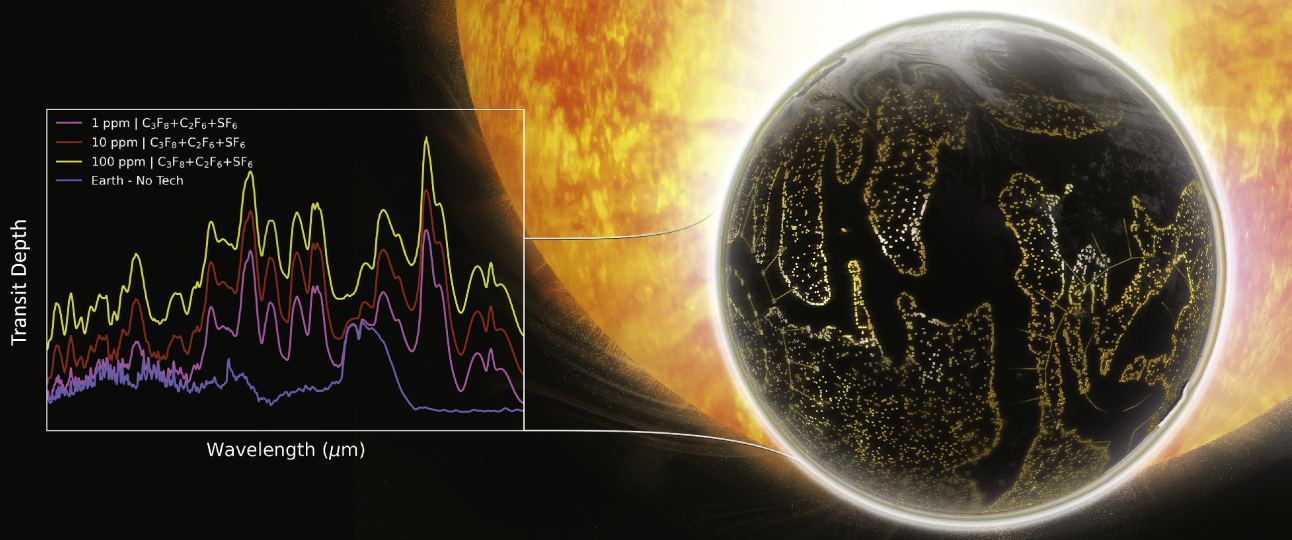
JUNE 28, 2024 BY EVAN GOUGH
Collected at: https://www.universetoday.com/167553/could-we-detect-an-alien-civilization-trying-to-warm-their-planet/
Humanity is facing an atmospheric threat of our own device, and our internecine squabbles are hampering our ability to neutralize that threat. But if we last long enough, the reverse situation will arise. Our climate will cool, and we’ll need to figure out how to warm it up. If that day ever arises, we should be organized enough to meet the challenge.
If there are other civilizations out there in the galaxy, one may already be facing a cooling climate or an ice age. Could we detect the greenhouse chemicals they would be purposefully emitting into their atmosphere in an attempt to warm their planet?
New research in The Astrophysical Journal explains how the JWST or a future telescope named LIFE (Large Interferometer For Exoplanets) could detect certain chemicals in an exoplanet’s atmosphere that signal an intentional attempt to warm it. The title is “Artificial Greenhouse Gases as Exoplanet Technosignatures.” The lead author is Edward Schwieterman, Assistant Professor of Astrobiology at UC Riverside and a Research Scientist at Blue Marble Space Institute of Science in Seattle, Washington.
“Atmospheric pollutants such as chlorofluorocarbons and NO2 have been proposed as potential remotely detectable atmospheric technosignature gases,” the authors write in their paper. “Here, we investigate the potential for artificial greenhouse gases, including CF4, C2F6, C3F8, SF6, and NF3, to generate detectable atmospheric signatures.”
The first three are perfluorocarbons, potent and long-lived greenhouse gases (GHGs.) SF6 is Sulfur hexafluoride, and NF3 is Nitrogen trifluoride. They’re both greenhouse gases with global warming potentials 23,500 times greater and 17,200 times greater than CO2 over a 100-year period.
These artificial GHGs could be a technosignature of a civilization actively trying to warm their planet. They’re long-lived, have low toxicities, and have low false-positive potential. They also occur only in small amounts naturally. Their presence indicates industrial production.
“For us, these gases are bad because we don’t want to increase warming. But they’d be good for a civilization that perhaps wanted to forestall an impending ice age or terraform an otherwise-uninhabitable planet in their system, as humans have proposed for Mars,” said UCR astrobiologist and lead author Edward Schwieterman.
These chemicals could persist in an atmosphere for up to 50,000 years, making them near ideal for a civilization facing a freezing future. “They wouldn’t need to be replenished too often for a hospitable climate to be maintained,” Schwieterman said in a press release.
Unlike CFCs (chlorofluorocarbons), which damage the ozone layer, these chemicals are largely inert. Any civilization smart enough to engineer their atmosphere would avoid CFCs. CFCs also don’t last long in an oxygen atmosphere and wouldn’t be great technosignatures.
“If another civilization had an oxygen-rich atmosphere, they’d also have an ozone layer they’d want to protect,” Schwieterman said. “CFCs would be broken apart in the ozone layer even as they catalyzed its destruction.”
But from our ETI-seeking viewpoint, the best thing about the chemicals the researchers are studying is their prominent infrared signatures at extremely low concentrations.
“With an atmosphere like Earth’s, only one out of every million molecules could be one of these gases, and it would be potentially detectable,” Schwieterman said. “That gas concentration would also be sufficient to modify the climate.”
To understand these chemicals and their detectability, the research team simulated the atmosphere of TRAPPIST 1-f. This well-studied rocky exoplanet is in the habitable zone of a red dwarf star about 40 light-years away, making it a realistic observational target at that distance.

This study is based on the potential results of the LIFE telescope, which is still a concept. Its purpose is to examine the atmospheres of dozens of warm, terrestrial exoplanets. LIFE builds on telescope concepts from a couple of decades ago, like the European Space Agency’s Darwin spacecraft. Darwin wasn’t built, but the idea behind it was two-fold: to both find Earth-like exoplanets and to search for evidence of life.
Darwin was conceived as an interferometer, and so is LIFE. LIFE would have four separate space telescopes acting as one.

With LIFE, the GHGs would be easier to see than other standard biosignatures like O2, O3, CH4, and N2O. But unlike these chemicals, which can give false positives without a planetary context, the GHGs are more akin to technosignatures, which can be understood more independently from atmospheric chemistry. “In contrast to biosignatures, many technosignatures may provide greater specificity (less “false positive” potential), as many putative technosignatures have more limited abiotic formation channels when compared to biosignatures,” the authors explain in their research.

One desirable aspect of the search for these technosignature GHGs is that astronomers can find them as part of a general effort to study atmospheres.
“You wouldn’t need extra effort to look for these technosignatures, if your telescope is already characterizing the planet for other reasons,” said Schwieterman. “And it would be jaw-droppingly amazing to find them.”

This is not a futuristic scenario awaiting the development of new technology. We have the capability to do this soon, according to Daniel Angerhausen. Angerhausen is from the Swiss Federal Institute of Technology/PlanetS, a collaborating organization on LIFE.
“Our thought experiment shows how powerful our next-generation telescopes will be. We are the first generation in history that has the technology to systematically look for life and intelligence in our galactic neighborhood,” said Angerhausen.

“While all technosignature scenarios are speculative, we argue that it is unlikely fluorine-bearing technosignature gases will accumulate to detectable levels in a technosphere due only to inadvertent emission of industrial pollutants (or volcanic production),” the authors write.
They also explain that before individual GHG technosignatures were identified, anomalous MIR or NIR absorption signatures “… would be consistent with the presence of artificial greenhouse gases in a candidate technosphere.”
In their conclusion, they say that GHGs are viable technosignatures that can be found during routine exoplanet characterizations. “Both positive or negative results would meaningfully inform the search for life elsewhere,” they conclude.

Leave a Reply